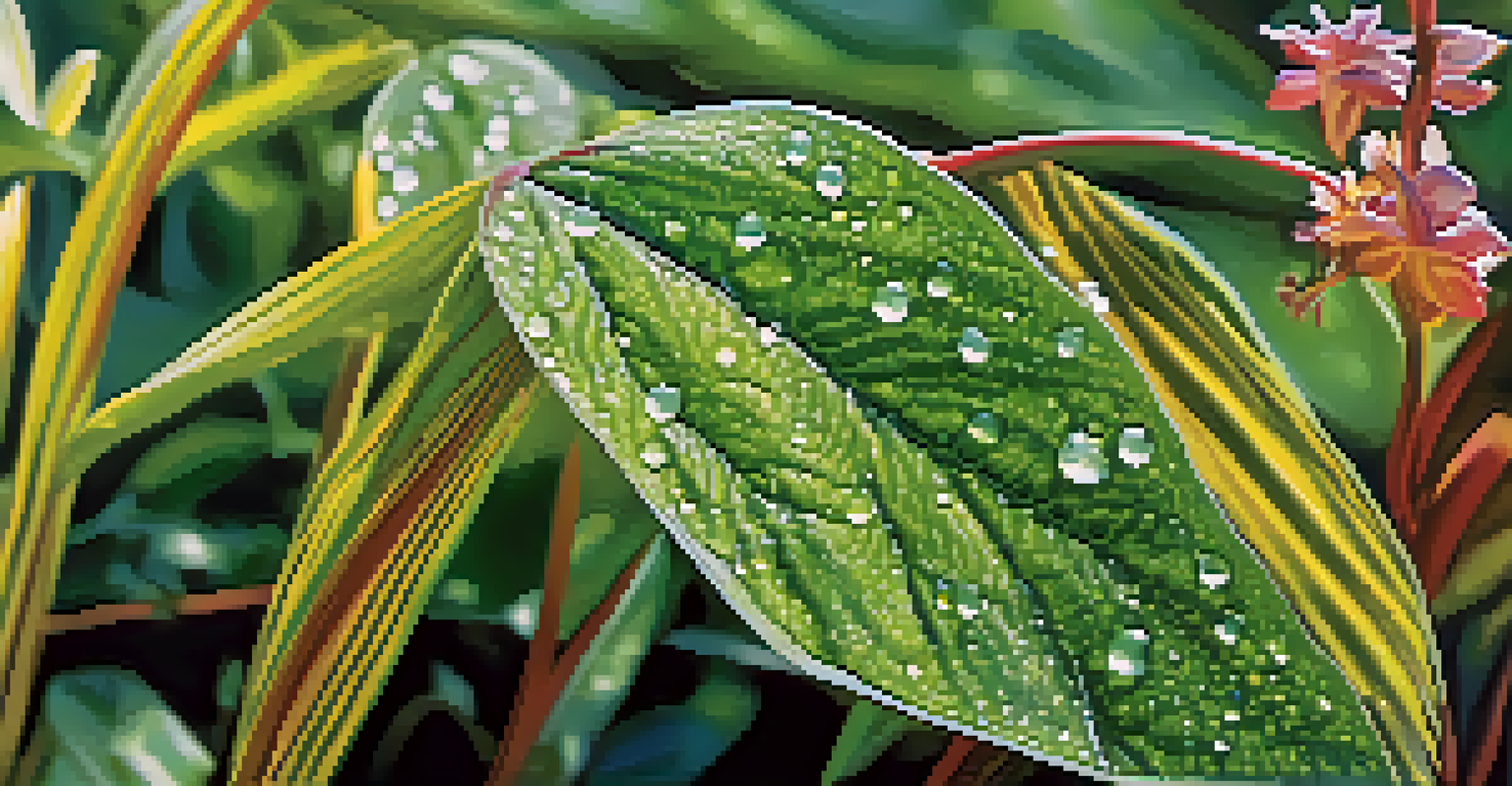Indigenous Plant Species: The Backbone of Local Ecosystems

Understanding Indigenous Plant Species and Their Importance
Indigenous plant species are those that naturally occur in a specific region, having evolved over thousands of years. These plants play a crucial role in maintaining the balance of local ecosystems. By providing essential habitat and food sources for native wildlife, they contribute to biodiversity and ecological stability.
The greatest threat to our planet is the belief that someone else will save it.
For instance, consider the vibrant wildflowers that bloom in your local meadows. Not only do they add beauty to the landscape, but they also attract pollinators like bees and butterflies, which are vital for plant reproduction. Without these indigenous plants, many local animals would struggle to find food and shelter, leading to a decline in their populations.
Furthermore, indigenous plants often possess unique adaptations that allow them to thrive in their native environments. This resilience makes them better suited to local soil conditions, climate, and pests, unlike non-native species, which can disrupt the existing ecosystem balance.
The Role of Indigenous Plants in Biodiversity
Biodiversity refers to the variety of life in a particular habitat, and indigenous plants are key players in this intricate web. They form the foundation of food chains and provide essential resources for countless organisms. A diverse plant community supports a wider range of animal species, creating a richer and more robust ecosystem.

Take, for example, a forest dominated by native trees. These trees not only provide shelter and food for birds and mammals but also create a microhabitat for smaller organisms like insects and fungi. This interconnectedness highlights how indigenous plants can sustain diverse life forms, ultimately contributing to a healthier environment.
Indigenous Plants Boost Biodiversity
Indigenous plants are essential for maintaining biodiversity, providing habitat and food for a variety of wildlife.
Moreover, preserving indigenous plant species helps maintain genetic diversity, which is crucial for the resilience of ecosystems. This genetic diversity allows ecosystems to adapt to changes, such as climate shifts or invasive species, ensuring their survival over time.
Ecosystem Services Provided by Indigenous Plants
Indigenous plants offer a variety of ecosystem services that benefit both the environment and human communities. These services include air and water purification, soil stabilization, and carbon sequestration. By absorbing carbon dioxide, native plants help combat climate change, making them vital for a sustainable future.
In every walk with nature one receives far more than he seeks.
Additionally, indigenous plants play a significant role in soil health. Their root systems help prevent erosion and promote soil fertility by enhancing nutrient cycling. This is especially important in agricultural areas where healthy soil is essential for growing crops sustainably.
Furthermore, many indigenous plants have medicinal properties that have been utilized by local communities for generations. By preserving these plants, we not only protect traditional knowledge but also open doors for potential discoveries in modern medicine.
The Impact of Invasive Species on Indigenous Flora
Invasive species pose one of the greatest threats to indigenous plants and ecosystems. These non-native species often outcompete local flora for resources, leading to a decline in biodiversity. When invasive plants take over, they can disrupt the delicate balance that indigenous species maintain within their ecosystems.
For instance, the spread of kudzu in the southeastern United States has smothered native plants, drastically altering the landscape and harming local wildlife. This example underscores the need for vigilance in protecting indigenous plant species from invasive threats.
Ecosystem Services from Native Flora
Native plants offer crucial ecosystem services such as air and water purification, soil health, and carbon sequestration.
To combat this issue, conservation efforts must focus on removing invasive species and restoring native habitats. This not only helps in preserving biodiversity but also revitalizes the ecosystem services that indigenous plants provide.
Cultural Significance of Indigenous Plants
Beyond their ecological importance, indigenous plants hold significant cultural value for many communities. Many Indigenous peoples have deep-rooted connections to their local flora, using plants for food, medicine, and spiritual practices. This cultural relationship emphasizes the importance of conserving these species for future generations.
For example, traditional practices may involve harvesting specific plants during certain seasons, reflecting the knowledge of their ecological cycles. By preserving these practices, communities can maintain their cultural identities while promoting environmental stewardship.
Moreover, educating younger generations about the importance of indigenous plants can foster a sense of connection and responsibility towards the environment. Understanding these cultural ties can inspire more people to engage in conservation efforts.
Conservation Efforts for Indigenous Plant Species
Conservation initiatives focused on indigenous plants are essential for maintaining healthy ecosystems. These efforts often involve habitat restoration, establishing protected areas, and promoting sustainable land use practices. By actively engaging in conservation, we can ensure that these vital plant species thrive for years to come.
Community involvement is key in these conservation efforts. Local groups and volunteers can be instrumental in planting native species, removing invasive plants, and educating others about the importance of biodiversity. This grassroots approach not only strengthens community ties but also cultivates a shared sense of purpose.
Cultural Value of Indigenous Plants
Indigenous plants hold significant cultural importance for many communities, serving as sources of food, medicine, and spiritual practices.
Additionally, collaboration between governments, non-profits, and educational institutions can amplify the impact of conservation initiatives. By pooling resources and knowledge, these partnerships can drive meaningful change and promote the preservation of indigenous flora.
How You Can Support Indigenous Plant Conservation
You might wonder how you can contribute to the conservation of indigenous plant species in your area. One simple way is to incorporate native plants into your garden or landscaping. By choosing indigenous species, you help support local wildlife and contribute to the ecosystem's health.
Participating in local conservation programs or volunteer days can also make a significant difference. Many organizations organize events focused on planting native species or removing invasive plants, and your involvement can help restore local habitats. Plus, it’s a great way to connect with others who share your passion for nature.

Lastly, spreading awareness about the importance of indigenous plants can drive community engagement. Whether through social media or local events, sharing your knowledge can inspire others to take action and contribute to the preservation of these vital species.